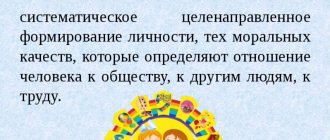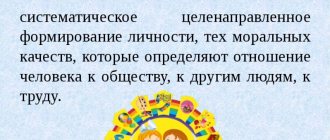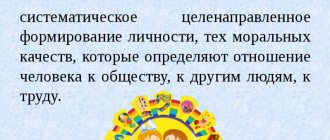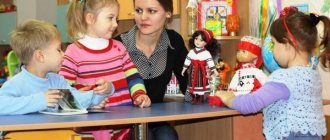We all come from childhood. Almost everyone listened to bedtime stories and imagined themselves as participants in magical adventures - the girls were fairies and princesses, the boys were the constant winners of dragons and all sorts of goblin-ghouls. But we hardly thought then that a fairy tale was a very important (if not the main!) element of our upbringing and the system of our ideas about the world, about good and evil, about work and “rewards” for laziness.
Now, sitting on the other side of the crib, it’s worth figuring out what a fairy tale is from a scientific point of view and how you can help your baby in temporary age-related or stressful situations, how can a fairy tale “cure” greed, enuresis, and fear of the dark?
So, welcome to the magical world of the fairy “wrong side”!
Where did the idea of education through fairy tales come from?
Classic of Russian pedagogy K.D. Ushinsky wrote that fairy tales are “the first and brilliant attempts of Russian folk pedagogy, and I don’t think anyone would be able to compete in this case with the pedagogical genius of the people.” The same opinion was shared by the researcher of Russian folklore V.P. Anikin, who said that “in the thought that gives life to fairy tales, the multifaceted mind of the people was manifested, their history, life, and worldview were deposited in crystals.”
One cannot argue with the value of fairy tales also because they begin to be read to children at an age when children are just beginning to form the rudiments of morality, goodwill, integrity and hard work.
A fairy tale, passing through centuries of folk wisdom, like a snowball accumulates all the most valuable things for children's preschool pedagogy. This is a unique way to raise a child not with the help of exhortations and abstract judgments, but with the help of direct experience and the actions of heroes who may or may not be loved, but are still very significant for the child. It is only important to manage this treasure wisely.
Currently, despite the obvious interest in fairy tales as an educational “tool,” there are many difficulties - the lack of consistency entails the lack of methods of pedagogical influence, and, therefore, affects the effectiveness of the pedagogical use of fairy tales. To this day, some teachers and educators find it difficult to imagine that, from the point of view of educating moral attitudes, the potential of a fairy tale is much more serious than its artistic and historical significance.
Consultation for parents "Parenting with a fairy tale"
Education with a fairy tale
“What a delight these fairy tales are!” exclaimed A.S. Pushkin.
An adult knows that a book not only teaches, develops and educates a child, it awakens a wide variety of creative principles in a little person, it helps a child’s imagination acquire rich imagery and inner meaning. A child cannot help but play, invent, and compose. This is inevitable, this is his way of penetrating reality. But what exactly is he inventing? How does he compose and why does he compose exactly this? What moral and aesthetic reasons are manifested in children's play, which little by little, often imperceptibly for the child himself, becomes his real life? The world of reading, the world of the book with its literary and graphic images, helps an adult to get enough and direct a child's imagination. The book gives the child an example of creativity, an example of a creative attitude towards the real world. It is here, on the book page, that children first encounter a harmonious reflection of reality. The book tells the most important things, shows the most beautiful things. There are different books in children's literature: funny and sad, but they are always life-affirming. Therefore, children cannot help but love the book, so they rejoice at the book as if it were a holiday. And adults must prepare this joy, help the child understand and feel the book in its entirety.
If a Fairy Tale is nearby, then the child strives to become better, learns to understand and love all living things, gets to know the world around him, tries to compose his own fairy tales, gets acquainted with difficult rules and concepts, eats the “magic medicine”, and goes to bed happily and without whims.
Children love to listen to fairy tales, which expand their knowledge and horizons, showing that in addition to the real world, there is also a magical world. It is through fairy tales addressed to the heart that the child gains deep knowledge about a person, his problems and ways to solve them. Let us remember how in real life people face good and evil. The form of teaching these concepts to an adult is not figurative. Children need imaginative play. A child's concept of goodness appears in a fairy tale in the form of a hero, a knight, a prince who embodies strength and courage, a kind sorceress or fairy who can always come to the rescue. Fairy tales tell about the feelings of the heroes, and not about external events, and the action unfolding in them often contradicts ordinary reality. A child, having heard and imagined fairy-tale images, easily learns to understand the inner world of heroes, empathize with them, believe in the forces of good, and gains self-confidence
Fairy tales should in no way be considered only as a pleasant activity accessible to children. With the help of fairy tales, you can educate a child and help overcome the negative aspects of his developing personality. For example, it is useful for a greedy, selfish child to listen to the fairy tale “About a Fisherman and a Fish”, “About Three Greedy Little Bears”; for the fearful and timid - “About the Cowardly Hare”; “The Adventures of Pinocchio” will help the playful and trusting one, “The Princess and the Pea” will help the capricious one, “Puss in Boots” will help the active and active fidget, tales about brave heroes and knights who dedicated their lives to exploits in the name of people.
Try to understand your baby's emotional problem (fear, loneliness, uncertainty, rudeness and other traits). Think about why he is anxious, aggressive, capricious - and compose a fairy tale where the heroes, their adventures and exploits will help the child solve his significant problem. Come up with a fantastic creature, let it overcome all difficulties according to a fairy-tale plot. Your child himself will feel help and find a way out of the traumatic situation.
When telling your child a fairy tale, be sure to come up with a good ending. Compose only those fairy tales that are close and understandable to your child.
“Education of moral qualities of a preschooler’s personality through a fairy tale”
(From work experience)
“It’s not for nothing that children love fairy tales.
After all, that’s what’s good about a fairy tale,
That there is a happy ending in it
The soul already has a presentiment..."
V. Berestov.
The Federal State Educational Standard for Education establishes the priority of the spiritual and moral education of preschool children.
It is well known that in the first 7 years a person acquires as much as he cannot acquire in his entire subsequent life, and omissions at this age are not made up for later. It is this age that cannot be missed for the formation of ideas about good and evil, about moral standards and moral standards of behavior and relationships.
The development of humane feelings in preschoolers is possible through immersion in the world of books, and especially in the world of fairy tales. They, tested over centuries, contain the wisdom of the people who created them, they contain the foundations of national culture. In fairy tales, good always triumphs over evil.
Determining the direction of educational work with children, I focused on the problem of forming the moral foundations of a preschooler’s personality through a fairy tale.
My students are 5-7 years old. These are children with disabilities who have characteristics that need to be taken into account when working with them.
The purpose of my work on this topic is : the formation of moral consciousness, sustainable moral behavior, and the ability to be guided in their actions, actions, and relationships by moral principles in older preschoolers with disabilities.
The tasks that I set for myself:
- Help children in mastering moral values, developing moral qualities in the process of establishing positive interpersonal relationships.
- Help children learn moral categories: good and evil, harmony, hard work, selflessness, etc.
- To promote the development of the ability to analyze the actions of other people, one’s own behavior in the development of the child’s moral qualities.
My work consists of stages.
I. Preparatory stage
- I organize the educational process with my students according to the adapted basic educational program of preschool education for children with disabilities, developed in accordance with the requirements of the Federal State Educational Standard for Education, as well as the Program of the Republic of Crimea “Crimean Wreath”, which is aimed at educating children of the multinational Crimea.
- I also use innovative technologies in my work:
— modern gaming technologies (a combination of games and learning);
— design technologies;
— information and computer technologies.
3. I constantly update the spatial development environment in the group in accordance with the requirements of the Federal State Educational Standard: I select and systematize materials, didactic and theatrical games, fiction, attributes for dramatization, different types of theaters aimed at the formation and education of moral standards.
4. I determine the directions of work with children when organizing different types of their activities (play, perception of fiction, communication, etc.).
At the second diagnostic stage
To identify the level of formation of moral ideas in September 2022. I conducted a study of the group’s students using the methodology proposed by G.A. Uruntaeva, Doctor of Psychology.
Criteria for the formation of moral ideas.
1. Stability of moral ideas.
2. A combination of moral images and behavior.
3. Moral assessment.
The study was carried out on the basis of reading the fairy tale “The Hare's Hut”.
After processing the results, the following data was obtained.
Stability of moral ideas:
A) Does he understand the meaning of the fairy tale?
B) What moral qualities does the fairy tale highlight?
B) Emotional state after reading a fairy tale.
- high level – 24%;
- average level – 52%;
- low level – 24%.
Combination of moral images and behavior:
A) Does the child motivate and how the intended action of the heroes.
B) Does speech express norms of behavior, does it name moral qualities.
- high level – 20%;
- average level – 44%;
- low level – 36%.
Moral assessment of the heroes’ actions:
A) How comprehensively and consistently explains the situation.
B) Does it highlight the moral qualities of the heroes.
- high level – 26%;
- average level – 38%;
- low level – 36%.
The analysis showed:
| high | average | short | |
| Stability of moral ideas: | 24% | 52% | 24% |
| Combination of moral images and behavior: | 20% | 44% | 36% |
| Moral assessment of the heroes’ actions: | 26% | 38% | 36% |
That according to all indicators, on average, 32% of pupils have a low level of stability of moral ideas, a combination of moral images and behavior, and a moral assessment of actions.
This indicator forms the basis for organizing my further work.
III practical stage
When organizing the activities of the practical stage, along with traditional forms of work (reading fairy tales and conversations on the content, didactic games based on fairy tales, including fairy tales when organizing educational activities, etc.), I also used innovative technologies.
Theatrical games based on fairy tales in joint activities with children, as the main model of the educational process. In the course of theatrical activities, dramatizations, costume parties, where the child plays a fairy-tale character, sympathy, understanding of the moral lessons of the fairy tale, and the ability to evaluate actions develop.
When the stock of fairy tales that children know and can tell became rich enough, we moved on to composing fairy tales, including using ICT. They happily and actively come up with their own fairy tales, in which they establish knowledge of the norms of moral behavior and moral qualities.
In my work I also use such pedagogical technology as project activities . For example, in the mini-project “Zayushkina’s Hut,” we first read a fairy tale, talked about the content, and then the children depicted the visual images created as a result of this in artistic activities (drawing, appliqué). In the final part of the project, the fairy tale was dramatized. Using the project method allows children to comprehensively comprehend the moral lessons of a fairy tale, show their likes and dislikes for the characters and their actions, and understand the motives of their actions.
IV Final stage.
At this stage, work on moral education continues. After conducting intermediate testing in January, I found that there were positive changes in the formation of the moral qualities of children’s personalities: moral ideas became more stable, they began to be more often guided by moral principles in their actions, they learned to give a moral assessment of their behavior and the behavior of their comrades.
A certain set of personal qualities and moral values appeared and began to be established, such as: mercy, compassion, love of truth, children’s desire for good and rejection of evil; the level of speech etiquette has increased; the ability to control one’s emotional state, conscious behavior and communication in society appeared.
After the work, I gained confidence that the development of a child’s morality must be carried out through fairy tales, because morality is initially inherent in their plots. The main conditions for such development should be considered the morality of adults themselves and its real manifestation in relationships with children.
The great teacher V.A. Sukhomlinsky said: “Through a fairy tale, fantasy, play, through unique children's creativity - the right path to a child’s heart. A fairy tale, a fantasy, is the key with which you can open these origins, and they will fill you with life-giving keys...”







